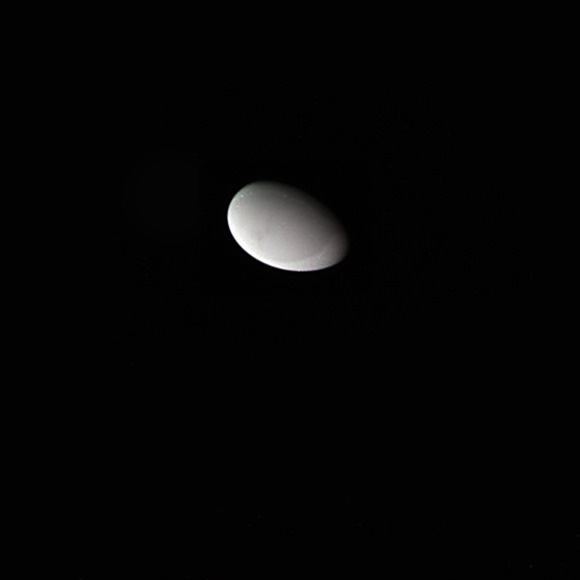[/caption]
While many of us here on Earth were waiting for the Moon to take a bite out of the Sun this past Sunday,
Cassini
was doing some moon watching of its own, 828.5 million miles away!
The image above is a color-composite raw image of Methone (pronounced meh-tho-nee), a tiny, egg-shaped moon only 2 miles (3 km) across. Discovered by Cassini in 2004, Methone's orbit lies between Mimas and Enceladus, at a distance of 120,546 miles (194,000 km) from Saturn -- that's about half the distance between Earth and the Moon.
At an altitude of 1,200 miles (1900 km) this was Cassini's closest pass ever of Methone, a rare visit that occurred after the spacecraft departed the much larger Tethys.
Along with sister moons Pallene and Anthe, Methone is part of a group called the Alkyonides, named after daughters of the god Alkyoneus in Greek mythology. The three moons may be leftovers from a larger swarm of bodies that entered into orbit around Saturn -- or they may be pieces that broke off from either Mimas or Enceladus.
Earlier on Sunday, May 20, Cassini paid a relatively close visit to Tethys (pronounced tee-this), a 662-mile (1065-km) -wide moon made almost entirely of ice. One of the most extensively cratered worlds in the Solar System, Tethys' surface is dominated by craters of all sizes -- from the tiniest to the giant 250-mile (400-km) -wide Odysseus crater -- as well as gouged by the enormous Ithaca Chasma, a series of deep valleys running nearly form pole to pole.
[caption id="attachment_95325" align="aligncenter" width="580" caption="Saturn's icy moon Tethys with Ithaca Chasma visible, seen by Cassini on May 20, 2012."]
[/caption]
[caption id="attachment_95326" align="aligncenter" width="580" caption="Tethys' rugged and heavily-cratered surface near the terminator"]
[/caption]
[caption id="attachment_95327" align="aligncenter" width="580" caption="Cassini looks down into the 62 mile (100 km) wide Ithaca Chasma "]
[/caption]
Cassini passed within 34,000 miles (54,000 km) of Tethys on May 20, before heading to Methone and then moving on to its new path toward Titan, a trajectory that will eventually take it up out of Saturn's equatorial plane into a more inclined orbit in order to better image details of the rings and Saturn's poles.
Read more about this flyby on the Cassini mission site
here
. and see more raw images straight from the spacecraft on the CICLOPS imaging lab site
here
.
Image credit: NASA / JPL / Space Science Institute. (Color-composite image edited by J. Major.)
 Universe Today
Universe Today
